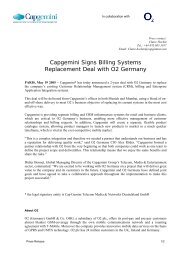You also want an ePaper? Increase the reach of your titles
YUMPU automatically turns print PDFs into web optimized ePapers that Google loves.
56 ANNUAL<br />
REPORT OF THE CHAIRMAN OF THE BOARD OF DIRECTORS<br />
<strong>Capgemini</strong><br />
dinating policies in this sphere throughout the Group and<br />
monitoring the performance of managers with high potential.<br />
- <strong>Capgemini</strong> University, which provides Group and staff managers<br />
with the additional training they require (in new technologies,<br />
assuming commercial functions, enhancing ability to<br />
handle large-scale projects, personal leadership development,<br />
etc.) and also forms a natural and convivial “meeting point”.<br />
The Strategy Department which is also in charge of the Group’s<br />
Transformation Program, and whose main role is to provide<br />
input and documentation for the deliberations on strategic<br />
issues by Group Management and by the Board’s Strategy Committee.<br />
The Communications Department, which is responsible for<br />
defining the guiding principles of the Group’s communications<br />
strategy and ensuring they are applied by the operating<br />
subsidiaries.<br />
The Sales and Alliances Department, which is in charge of<br />
coordinating the Groups’ sales policy, monitoring the management<br />
of major accounts and facilitating contacts with the<br />
Group’s partners.<br />
The Production and Quality Department, which is tasked with<br />
designing and disseminating proprietary production methodologies<br />
for internal use, providing certification for certain categories<br />
of staff (project leaders, architects, etc.), overseeing the<br />
smooth functioning and development of the Group’s delocalized<br />
production centers and performing audits of risk-sensitive projects,<br />
conducted by specialized teams known as “flying squads”<br />
(93 audits of this type were carried out in 2006).<br />
These bodies are supplemented by two ad hoc committees composed<br />
of the Chief Executive Officer, the Chief Financial Officer<br />
and the General Secretary. Their task is to review – within the<br />
scope of the restrictions placed on the powers of the Chief Executive<br />
Officer:<br />
with the Director of Risk Management and the Director of International<br />
Legal Affairs: major business proposals to be prepared<br />
or discussed, offers of strategic alliances and master contracts<br />
with clients or suppliers that meet a certain number of specific<br />
criteria (Group Review Board).<br />
with the Strategy Director and the M&A Director: plans for<br />
acquisitions or divestments up for discussion, selection or<br />
negotiation (M&A Committee).<br />
3.2.2 Clear lines of organization at operational level<br />
The Group’s operations are based on a decentralized model,<br />
consisting of five Strategic Business Units (SBUs), with substantial<br />
autonomy in their management. Two of these units are each<br />
responsible for the worldwide management of one of the Group’s<br />
four disciplines: one for Outsourcing Services and the other for<br />
Local Professional Services (*). The Group’s other two disciplines<br />
(Consulting Services and Technology Services) are organized into<br />
REPORT 2006 <strong>Capgemini</strong><br />
three major geographic zones: North America, Western Europe<br />
(the UK, France, Spain and Portugal) and Continental Europe<br />
(the Nordic countries, Benelux, Germany, Switzerland, Austria,<br />
Italy and the other central and eastern European countries) within<br />
which Asia-Pacific has been provisionally classified.<br />
Within each of these SBUs, the basic operating entity is the Business<br />
Unit (BU). These units are deliberately kept small enough to<br />
allow their managers to form strong relationships with their staff,<br />
and each one operates in a manner similar to a small business,<br />
complete with management and performance measurement tools<br />
that allow the manager to remain in close contact with staff and<br />
clients and to participate fully in the Group’s results and development.<br />
BU managers are fully responsible for meeting quantifiable<br />
targets relating to financial performance (growth, profitability,<br />
etc.), business development, the quality of management and the<br />
level of satisfaction among their clients.<br />
(*) A sixth SBU is in the process of being set up, and will have worldwide responsibility<br />
for Financial Services.<br />
3.2.3 Clearly defined processes and methods<br />
The proper functioning of the Group’s executive management<br />
structure and its Business Units is rooted in compliance with<br />
processes and methods that ensure efficient and traceable decision-making.<br />
3.2.3.1 Formal process for delegating powers and authorizing<br />
decisions<br />
The decision-making process applied within the Group is based<br />
on rules for the delegation of powers. These rules are regularly<br />
updated, comply with the principle of subsidiarity and define<br />
three levels of decision-making depending on the issues involved,<br />
corresponding to the three levels of <strong>Capgemini</strong>’s organization:<br />
the BU, for everything within its area of responsibility;<br />
the SBU, for everything that concerns the BUs under its authority;<br />
finally, the Group (Group Management, Executive Committee,<br />
etc.), for everything outside the scope of responsibility of a single<br />
SBU, for decisions which, by their nature, must be taken at Group<br />
level (acquisitions, disposals, etc.) or for other major operations<br />
whose impacts exceed well-defined materiality thresholds.<br />
This process has been formalized in an “authorization matrix”<br />
which requires both prior consultation and the provision of<br />
sufficient information to the parties involved. Recommendations<br />
submitted to the final decision-maker must include the views<br />
of all interested parties as well as a balanced assessment of the<br />
advantages and drawbacks of each of the possible solutions.<br />
3.2.3.2 A framework of general policies and procedures<br />
The Blue Book sets out the main principles and basic guidelines<br />
underpinning the Group’s internal control procedures, and covers















